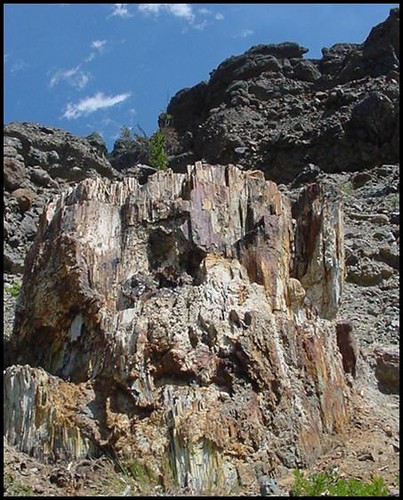
Imagine nearing the remote, rugged crest of the Gallatin Range in Montana’s Gallatin National Forest. As you scramble up-slope, you put your hand against what appears to be a lightning-blasted stump for balance. But the stump is not weather-polished wood—it’s made of stone.
These are the 50-million-year-old remains of redwoods, pines and sycamores which make up the Gallatin Petrified Forest, where fossilized tree trunks are preserved in so much detail that cellular structures may be seen under a microscope and growth rings are often visible to the naked eye. But how did these trees turn to stone?
Transport yourself back to the Eocene epoch, when a 9,200-foot volcano rose ominously out of a forested valley. A thin, dark plume of steam and ash shoots up from the angry crater. The 3-foot-thick trunks of mature redwood trees in the valley swayed and heavier branches crack and fall from the stress of earth tremors that become increasingly violent over a period of weeks. Suddenly, with a wrenching ground spasm and booming roar, the plume morphs into a thick roiling column of ash and volcanic ejecta that rockets 19 miles up into the stratosphere, spilling outward as it rises. The fallout coalesces into a thick debris cloud that spreads across the horizon in only minutes, turning day into night. Massive quantities of charged volcanic particles inject into the atmosphere generating a near-continuous series of lightning flashes accompanied by peals of deafening thunder.
Volcanic ash fall begins to pour from the sky at rates up to a foot an hour. Torrential rains join the ash fall, and flowing slurries of ash and coarse volcanic debris—which had eroded from the steep slopes of nearby inactive volcanoes—quickly choke off stream channels crossing the forested valley.
Viscous floodwater slurries of volcanic sediment overtop natural levees and sweep inexorably across the forest floor, depositing thick layers of coarse sediment while airborne volcanic debris shower down. Heavy, wet volcanic ash strip trees of their foliage and branches. The vegetation, rooted in place, is doomed.
As the eruption tapers to a halt, a once lush, verdant forest transforms into an eerily silent, sterile, bleak gray landscape. The naked boles of dead tree trunks poke out of a thick blanket of volcanic debris. Mineral-saturated groundwater circulates through the volcanic sediments, where the buried trunks already begin to absorb silica molecules into their pores, initiating the process of fossilization which will continue for millennia.
But, nature is resilient even in the face of catastrophic geological forces, and within months, seeds and spores of pioneer plant species borne by the wind and the droppings of birds flying overhead settle and germinate in the nutrient-rich volcanic soils. Within a decade the plain is covered in grasses—small clusters of young trees and shrubs beginning to poke above. The surrounding volcanos remain dormant, and within 25 years as patches of woodland develop, the forest’s rebirth is well underway.
Seven hundred years later, a new forest emerges to the same majestic grandeur as its predecessor buried below. Suddenly, a new volcanic plume arises against the horizon and the earth tremors again—a cycle that would repeat more than 24 times in the Greater Yellowstone area.
Today, you can visit this ancient forest. Stop by one of the Gallatin National Forest offices for directions and to obtain a permit allowing the collection of a small sample of petrified wood from the Special Management Zone. Small pieces that are loose on the ground are suitable for collection, but petrified trunks preserved in place must not be damaged or disturbed.
